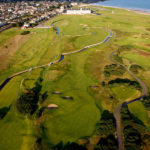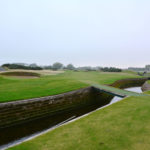Carnoustie Golf Links-Angus, Scotland-Home of The Most Underrated Golf Course in the World
The long days of summer are when professional golfers make their hay.
These are the significant money events, including the “Majors.”
More often than not a strong showing in the four major championships, (i.e., The Masters, US Open, The Open Championship and the PGA) can make or break a successful season and in turn, translate that success into enhanced marketing opportunities and sponsorships.
But these are important tournaments for everyone, not just the contestants.
Everyone that plays golf, loves golf and participates in golf whether its actively or not, all share in the triumphs, downfalls, highs, lows, the passion, and the ultimate conclusion.
There is always a Champion. And it’s almost always an essential and dramatic moment in golf history. These Championships are the defining pinnacles in the sport of golf.
It’s on these bigger stages, under the harsh floodlights of an international audience when indulged professionals leave the warm confines of the PGA Tour.
They venture out into the harsh realms of Major Championship golf, and the golf world’s angst levels increase, subplots abound, and the collective vision of a much broader audience squeezes oh so much tighter on the entire process.
And so, it was at Shinnecock Hills on the eastern end of Long Island this past June.
 The United States Golf Association came under fire again for its handling of the 2018 US Open Championship contested June 14-17.
The United States Golf Association came under fire again for its handling of the 2018 US Open Championship contested June 14-17.
Brooks Koepka was a repeat winner with a score of 281, one over par for the tournament, becoming only the third golfer in history to defend his title in this championship. Curtis Strange won in 1988 and 1989, and Ben Hogan claimed the trophy in 1950 and 1951.
The US Open is a severe test and hard to win, as it should be, it’s our national championship. But sometimes the tournament conditions border on the extreme.
This year was no exception as 156 of the best players in the world started the competition and not one of them better par over four days, as the golf course exacted its toll.
Much was said by the media, players, and observers about the difficulty of the setup, preparation of the course and the USGA’s continued mismanagement of our national championship.
After all, this is a repeat of what happened the last time the Open was held at Shinnecock in 2004 and has continued through other events conducted by the USGA.
The blue blazers in charge should know better.
Having covered more than 100 major championships, including over thirty US Opens, people ask me often what it’s like to attend and report on these championships.
Here’s what I tell them.
First of all, none of these competitions fall under the management of the PGA Tour.
That’s a misconception people often forget. They’re used to seeing the weekly tournaments on television and all the accompanying glamour associated with perfect conditions, massive corporate sponsorships, and galleries of adoring fans.
However, major championships do not use the same blueprint, business model or structure. The PGA Tour has nothing to do with these championships other than they are on the same schedule.
That said, here are my rankings of the four contests, actually five as I am also counting the Ryder Cup, based on my many years of involvement with these major championships
 The Masters is #1 for all the obvious reasons. First and foremost is the golf course. The Masters is the only major championship that returns to the same venue every year, The Augusta National Golf Club. The National is a very exclusive private club, and the membership conducts the tournament. They do not answer to any outside noise at all.
The Masters is #1 for all the obvious reasons. First and foremost is the golf course. The Masters is the only major championship that returns to the same venue every year, The Augusta National Golf Club. The National is a very exclusive private club, and the membership conducts the tournament. They do not answer to any outside noise at all.
At the Masters, tradition is everything and the “Patrons” as Bobby Jones called them, are often overwhelmed by Augusta National’s courtesy and accommodations for their wellbeing. It’s a joy to walk through the gates of the Augusta National for any reason, especially the Masters.
The PGA is #2 because they go out of their way to make it an excellent experience for everyone involved and this includes the Ryder Cup, which is #2a. Both of these championships are owned by the PGA of America, which is entirely separate from the PGA Tour.
The PGA of America, registered as a non-profit, 501(c) Corporation, states its business plan is to give back all profits to its membership in the way of education, member benefits, and player development. The model includes its championships which offer many amenities that other tournaments don’t. The PGA also makes it a point to feature newer golf courses that generally allow public access. It makes it that much better if you can visit and play the same golf course you see on television.
The PGA Tour’s business model, while also a 501(c) corporation, is all about raising money for charity, tournament purses, and protecting its brand, and that’s a whole different ball of wax.
The Open Championship, or British Open as we Americans call it, is #3 because of the historic nature of the golf courses in the rotation and the time-honored traditions surrounding each of those venues.
The current Rota consists of nine golf courses of which five are in Scotland and four in England. These golf courses, because the Open returns to them often, are well known for their history, natural settings, and links-land qualities.
The Royal and Ancient Golf Club of St Andrews supervises the Open Championship. Much like the other organizations, the R&A runs their event under their rules, and as you might expect, sometimes those rules differ between organizations.
The US Open is, in my opinion, dead last among the four major championships to watch, attend and broadcast for different reasons.
While the anticipation of attending these championships is always exciting, the US Open is not fun for anyone involved because its run by volunteers and anything that can go wrong will. This playbook is a fact of life that never fails and always disappoints. The arrogance of the USGA in its course setup and defending par is a travesty. Par, of course, is an arbitrary number, and the USGA is on record as saying, “We are not trying to embarrass the best players in the world, we are trying to identify them.”
But that is a lie.
The USGA is hell-bent on making it challenging for everyone, from spectators, volunteers, players, media, etc., to enjoy themselves during Championship week.
And that, based on my experience, is a fact.
Think about it. To conduct our national championship, it takes a small army, almost 5,000 people, who give up two weeks of their lives to sit at an assigned station and endure endless abuse while trying to herd tens of thousands of spectators somewhere else rather than where they find themselves. All while trying to make sense of a golf course so far removed from its normal condition it borders on the absurd.
The USGA has touted its penchant for picking golf courses the public can play, but that’s a lie also. I’ve played many of the golf course’s that have hosted US Opens and believe me; open courses are not the same courses the public will play. The USGA makes sure of that.
Yes, Shinnecock is a brutal test of golf, but the venue is also one of the highest ranked golf courses on the planet coming in at #6 on the list of top 100 golf courses in the world.
The golf course should be able to stand on its own, not as a manufactured, dried out, un-kempt caricature of itself. I have seen this same narrative repeated time and time again.
The USGA takes an absolute treasure of golf course architecture, and more often than not, a top 100 ranked golf course and turns those courses into a monster that no one can recognize let alone play.
It’s time for the USGA to give up their business model of being the hardest, sternest test in the majors and let the golf course prevail on its merits. The lowest score wins. The golf course should be able to stand on its own. Not the player who gets the luckiest bounce or happily finds their ball in manufactured rough on fairways so narrow spectators can talk to each other from across the other side.
In my opinion, that’s not the golf I want to see and, I’m pretty sure that’s not the golf you want to watch either.
Which brings us to The Open Championship played July 19-22, and this year’s venue, Carnoustie Golf Links, in Angus, Scotland
Carnoustie could be and probably is, the most underrated golf course in the world. It indeed is one of the fiercest tests in all of golf. And numbers back that up.
If one was to analyze the scoring records of Major Championships over the last twenty-five years, Carnoustie holds the highest average score relative to par of any championship course including Shinnecock this year.
In 1999, the year Jean Van de Velde made a triple-bogie on the last hole to lose a three-shot lead, and ultimately the Championship, the average score for all contestants was 5.82 over par.
That is still the highest average score over par ever recorded in modern history and led to the bestowing of the infamous nickname of “Carnasty.”
It’s not Carnoustie, its Carn-Nasty with capital letters.
By comparison, the average score, this year at Shinnecock was 4.65 over par. But guess what? The Blue Blazers at the United States Golf Association took two years in preparation to muddle up a top-ten ranked golf course into an unplayable mess the average golfer could not break 100 on, even if they got lucky.
And that’s a travesty.
Carnoustie, on the other hand, will be the same golf course that mother nature built almost 500 years ago.
 And while it ranks fourteenth on Golfweek’s list of classic golf courses and is eminently playable, it remains a public golf course in the middle of a little Scottish town and accessible to all who make the journey across the Firth of Tay, hard by the North Sea, in Northern Scotland.
And while it ranks fourteenth on Golfweek’s list of classic golf courses and is eminently playable, it remains a public golf course in the middle of a little Scottish town and accessible to all who make the journey across the Firth of Tay, hard by the North Sea, in Northern Scotland.
The R&A typically does nothing more, to their championship golf courses, than set up the grandstands behind the putting greens and tees and maybe trim those little sod bricks that line all those bunkers you can’t see over.
Hell, they very seldom water or even mow the courses.
Mother Nature provides some of the irrigation when it rains, and flocks of sheep keeps the grass down. Seriously, other than the regular maintenance on the tees and greens, the golf courses are on their own and played the way nature intended them.
And that’s a good thing.
Let the players play.
Lowest score wins.
As an aside, another thing I’ve always found remarkable, since my very first sojourn into golf on the British Islands, is two of the best and most traditional links golf courses in the world, are just ten miles apart as the crow flies.
Most golf people have no idea that only a few miles of estuary separate Saint Andrews and Carnoustie on protruding and parallel peninsulas jutting like twin companions into the North Sea.
This geographic oddity, of course, is what gestated their greatness and gave them their identity.
In the infancy of golf course development, links-land utilized the sometimes broad and expansive sandbars that separated agricultural friendly inland soil, from salt infested and uninhabitable shorelines.
Links land fulfills nature’s purpose by applying this hostile, windswept, and sandy links terrain, basically useless for any commercial activities except as a shield to protect arable land from the mercy of nature’s elements.
That is until golf became fashionable in the sixteenth century and golfers, needing places to play, and with other available lands scarce and expensive, migrated to these land masses and let nature develop the layout of the holes.
Authentic links land is treeless, formless, fluid and steadily being shifted and re-shaped by the forces of Nature. The wind and sea are ever-present as creators while the inescapable elements provide a stern defense.
And so, it is with Carnoustie.
But the weather is a short-term factor that also enters the equation. This summer has been dry and warm in Scotland, which is both good and bad. When the weather is hot, the golf course dries out, and native grasses go dormant.
It never fails when unsuspecting viewers tune into Open broadcasts and see the golf course for the first time. It’s nothing they anticipated. Shades of brown, yellow and greys with lots of gorse and natural areas and very, very fast. The golf ball seems to run forever, and scores go down.
When the weather is wet and cool, the grass grows, the course slows down, rough gets long and nasty, and scoring becomes more difficult.
For fans of links golf, this is precisely the way it should be. A real test that allows you to play the course as it is, not a manufactured reality show. The winner shoots the lowest number regardless of what par is.
Eight times the Open Championship has been contested at the Carnoustie Links. The list of champions reads like a veritable who’s who of golf legends including Tommy Armour, Henry Cotton, Ben Hogan, Gary Player, Tom Watson. Paul Lawrie and Padraig Harrington.
When Harrington won in 2007 with a winning score of 277, seven under par, the golf course was dry and fast.
Lawrie’s record making score in 1999 of 290, six over par, came when conditions were chilly and moist, the rough was unplayable and advancing the ball was difficult.
If history repeats itself, and the forecast calls for more dry, hard and fast conditions, then scores will be low.
 But know this, regardless of the conditions, the winner of this championship will be the player who drives it well, avoids the massive bunkers lurking on every hole and escapes Barry’s Burn, the narrow waterway that meanders across the course eight times, including three times on #18 alone, making it the hardest finishing hole in all of the major championships.
But know this, regardless of the conditions, the winner of this championship will be the player who drives it well, avoids the massive bunkers lurking on every hole and escapes Barry’s Burn, the narrow waterway that meanders across the course eight times, including three times on #18 alone, making it the hardest finishing hole in all of the major championships.
In fact, holes fifteen-thru-eighteen are the most challenging finishing holes anywhere in competitive golf, while the par-3 sixteenth is rated one the best par-3’s in the world.
It’s man against the course with no letup and no bailouts coming down the stretch.
Carnasty indeed.
2018 is also the last year The Open Championship will be third on the schedule of major championships.
In 2019 the PGA Championship, the traditional end of the golf season, moves to May, setting up consecutive events with the Masters contested in April. The PGA Championship in May. The US Open follows in June, and The Open Championship remains in the middle of July.
There is some irony that the oldest championship in golf history will now become the last contest on the championship schedule and the crown jewel of the majors.
The winner, along with the iconic claret jug trophy, is also awarded the “Champion Golfer of the Year” distinction and now gets bragging rights as the reigning major champion for almost a year until the Masters in early April.
The Open Championship, played this year at Carnoustie, is golf as it is meant to be. A blue-collared, links-style golf course, with no tricks, treats or unwelcome surprises. A pure test of golf on histories grandest stage, on a golf course that has stood the test of time.
Just as Mother Nature always intended.
Jeff Waters is a PGA Master Professional and a member of the Golf Writers Association of America.



